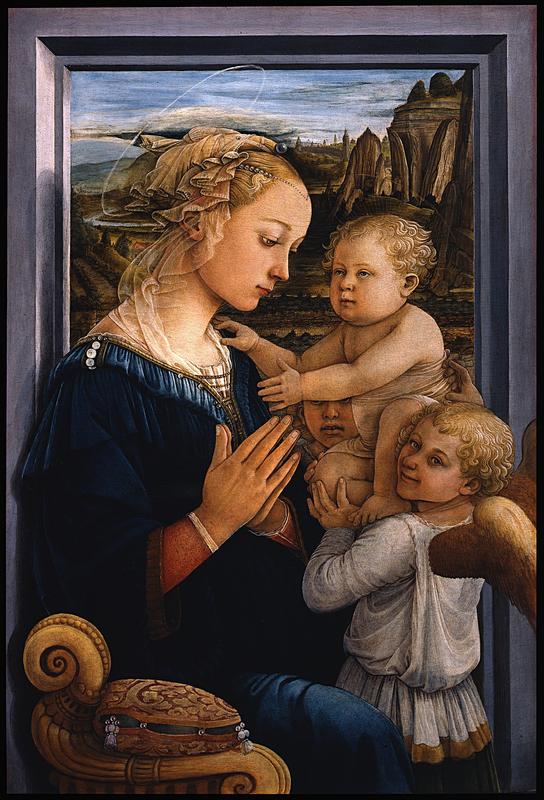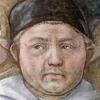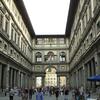More about Madonna and Child with Two Angels

Contributor
Friar Filippo Lippi’s Madonna has a secret, but not the one you think.
Madonna and Child with Two Angels was completed between 1460-1465, and this has become his most famous painting and one of the favorites of the oft repeated theme of the Virgin Mary and baby Jesus. Between you and me, I find the angels a little creepy and the baby Jesus a bit...sleepy? Drunk? But there’s a great story behind the piece, and that combined with Mary’s pearly crown and blue velvet dress are enough to reel me in.
At first glance, this work appears to be just another Madonna and child portrait, although skillfully rendered and very detailed. However, the relaxed nature of the angel in forefront and the intimacy between the mother and child made this portrait somewhat unprecedented when it hit the scene in the mid 1400’s. Some of the classic elements are still present, like their halos, signifying their holiness, and Mary’s hands clasped in prayer as a symbol of her piety and her act of charity in sacrificing her son. Her expression is somewhat classic as well, not smiling or particularly joyful presumably because of the divine knowledge that her son would die a terrible death. But unlike many portraits of the virgin, Mary does not look into the eyes of the viewer in confrontation, but instead enjoys the moment of joy she has with her son. This intimacy was what made the portrait so popular, but also so so juicy.
Until recently, there was absolutely no doubt in most art historians’ minds that the woman who modeled for this portrait was Friar Lippi’s lover, the nun Lucrezia Buti. You may be wondering Wait...aren’t nuns and friars supposed to be celibate?! You’re totally right! That was kind of a no-no.
Lucrezia and Filippo met when he became the headmaster of her nunnery, Santa Margherita. Some speculate they first got to know each other when she was modeling for paintings in surrounding Prato. We know some basics about the couple. The year Lippi became chaplain of her nunnery, she and her sister moved out of their convent and into Lippi’s cottage. By 1457, they had a son named Filippino. We don’t have first hand accounts of their relationship, and therefore can’t know much about how power played into the whole thing or if they were simply in ~LoVe~. However, Filippino’s will shows Lucrezia and Filippi also had a daughter together and it’s generally agreed that they lived in sin (not married) until Lippi’s death.
There’s no actual proof that this blonde babe is Lucrezia, but most scholars from an earlier time LOVE to speculate that Buti was modeling for this painting, and many other Lippi pieces. Given that the portrait was painted after the birth of his son in 1457, even art historians now can’t deny that at the very least some of the intimacy of watching Lucrezia raise their new son Filippino must have influenced Lippi.
Lippi painted a multitude of Madonnas but this is his most popular with art history buffs, because of its excellent execution in the rendering of faces, sensuous fabrics, and architectural elements. It is also the favorite because of the relaxed and serene intimacy between the Madonna and child, and the impish nature of the little angels. Many art historians cite this painting as one of the earliest intimate depictions of the Virgin and Child, and symbolic of a bigger change in the church. . Eventually more portraits like this became popular, and Lippi is to thank for that.
Not all Madonnas are created equally, and this one depicting a rebellious nun will stay at the top of my list.
Sources
- Anderson, A. J. The Joyous Friar ; the Story of Fra Filippo Lippi. New York: Frederick A. Stokes Company, 1927.
- Fossi, Gloria. Filippo Lippi. Library of Great Masters. Florence, Italy : New York: SCALA ; Riverside, 1989.
- "Fra Filippo Lippi." Artist Information. Accessed January 29, 2019. https://www.nga.gov/collection/artist-info.1489.html. Updated January 2018.
- "Fra Filippo Lippi." The National Gallery UK. Accessed January 29, 2019. https://www.nationalgallery.org.uk/artists/fra-filippo-lippi. Updated January 2019
- Holmes, Megan. Fra Filippo Lippi the Carmelite Painter. New Haven [Conn.]: Yale University Press, 1999.
- "Madonna and Child with Two Angels." Uffizi Gallery. Accessed January 25, 2019. https://www.uffizi.it/en/artworks/madonna-and-child-with-two-angels.
- "One of Our Nuns Is Missing | Art | Agenda." Phaidon. Accessed January 26, 2019. https://www.phaidon.com/agenda/art/articles/2011/october/07/one-of-our-….
- Strutt, Edward C. Fra Filippo Lippi. London: G. Bell, 1901.
Featured Content
Here is what Wikipedia says about Madonna and Child (Lippi)
Madonna with Child (Italian: Madonna col Bambino e angeli or Lippina) is a painting by the Italian Renaissance artist Filippo Lippi. The date in which it was executed is unknown, but most art historians agree that it was painted during the last part of Lippi's career, between 1450 and 1465. It is one of the few works by Lippi which was not executed with the help of his workshop and was an influential model for later depictions of the Madonna and Child, including those by Sandro Botticelli. The painting is housed in the Uffizi Gallery, Florence, Italy, and is therefore commonly called “The Uffizi Madonna” among art historians.
Check out the full Wikipedia article about Madonna and Child (Lippi)












